

Prolog Guide - First Steps. Helpful notes on how to use Prolog. You will be using either either on PCs, Linux machines or Macs, or on remus.rutgers.edu.
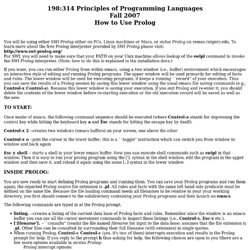
To learn more about the free Prolog interpreter provided by please visit: For SWI, you will need to make sure that your PATH on your Unix machine allows lookup of the command to invoke the interpreter. (Note: how to do this is explained in the installation docs.) If you want, you can run either Prolog from within emacs, using a two window (i.e., buffer) environment which encourages an interactive style of editing and running Prolog programs. Introduction to Prolog - The Mind Project. What is Prolog?
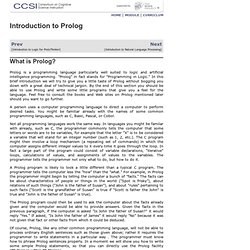
Prolog is a programming language particularly well suited to logic and artificial intelligence programming. "Prolog" in fact stands for "Programming in Logic. " In this brief introduction we will try to give you a little taste of Prolog without bogging you down with a great deal of technical jargon. By the end of this section you should be able to use Prolog and write some little programs that give you a feel for the language. 10.3 Negation as failure. One of Prolog's most useful features is the simple way it lets us state generalizations.
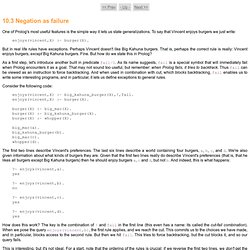
To say that Vincent enjoys burgers we just write: enjoys(vincent,X) :- burger(X). 10.3 Some Prolog Revision. There are two Prolog techinques that will be important in the implementation of the recognizer: First, database manipulation, and second, failure driven loops.
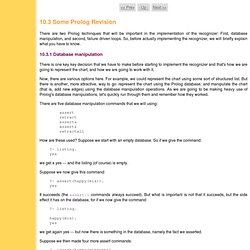
So, before actually implementing the recognizer, we will briefly explain what you have to know. 10.3.1 Database manipulation There is one key key decision that we have to make before starting to implement the recognizer and that's how we are going to represent the chart, and how we are going to work with it. Now, there are various options here. For example, we could represent the chart using some sort of structured list.
An introduction to Prolog! 5.1 Fail The fail/1 predicate is provided by Prolog.
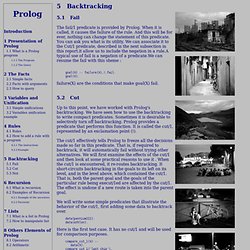
When it is called, it causes the failure of the rule. And this will be for ever, nothing can change the statement of this predicate. You can ask you what is its utility. Lexical elements and delimiters in Prolog. [Contents] [Top] [Help] [(c)] [Contact]
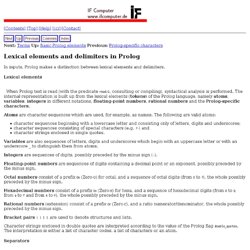
Prolog Terms. The generic name for all forms of Prolog data is "term".

The data your program works with is all terms of one form or another. The program itself is made up of terms. Prolog execution is simply the repetitive matching of patterns in these terms. This section describes the various forms of terms. They are: Hints on Prolog. 1. Prolog Lists - Prolog Site. A list is either empty or it is composed of a first element (head) and a tail, which is a list itself.
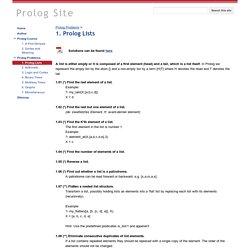
In Prolog we represent the empty list by the atom [] and a non-empty list by a term [H|T] where H denotes the head and T denotes the tail. 1.01 (*) Find the last element of a list. Example: ? - my_last(X,[a,b,c,d]). X = d. Prolog/Lists. Lists[edit]
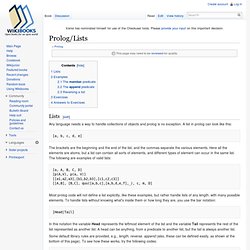
Scheme (programming language) The Scheme language is standardized in the official IEEE standard,[2] and a de facto standard called the Revisedn Report on the Algorithmic Language Scheme (RnRS). The most widely implemented standard is R5RS (1998),[3] and a new standard R6RS[4] was ratified in 2007.[5] Scheme has a diverse user base due to its compactness and elegance, but its minimalist philosophy has also caused wide divergence between practical implementations, so much that the Scheme Steering Committee calls it "the world's most unportable programming language" and "a family of dialects" rather than a single language.[6] A new language standardization process began at the 2003 Scheme workshop, with the goal of producing an R6RS standard in 2006.
This process broke with the earlier RnRS approach of unanimity. R6RS features a standard module system, allowing a split between the core language and libraries. Scheme Tutorial. Welcome to schemers.org! The Scheme Programming Language, 4th Edition. The Scheme Programming Language, 3rd Edition. Scheme Language. Lisp done right, according to some.
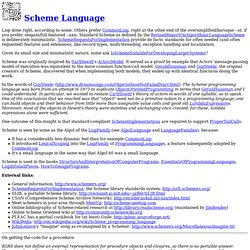
Others prefer CommonLisp, right at the other end of the oversimplified/baroque - or, if you prefer, elegant/full-featured - axis. Standard Scheme as defined by the RevisedReportOnAlgorithmicLanguageScheme is deliberately minimalistic. SchemeRequestsForImplementation provide de facto standards for often needed (and often requested) features and extensions, like record types, multi-threading, exception handling and localization. MIT/GNU Scheme. MIT/GNU Scheme is an implementation of the Scheme programming language, providing an interpreter, compiler, source-code debugger, integrated Emacs-like editor, and a large runtime library.
MIT/GNU Scheme is best suited to programming large applications with a rapid development cycle. Release status and future plans The releases provide binaries that run on i386 and x86-64 machines under the following operating systems: GNU/Linux, OS X, and Windows. We additionally provide binaries for selected other architectures and systems, depending on the hardware and software that is available to us. We no longer support OS/2, DOS, or Windows systems prior to XP.